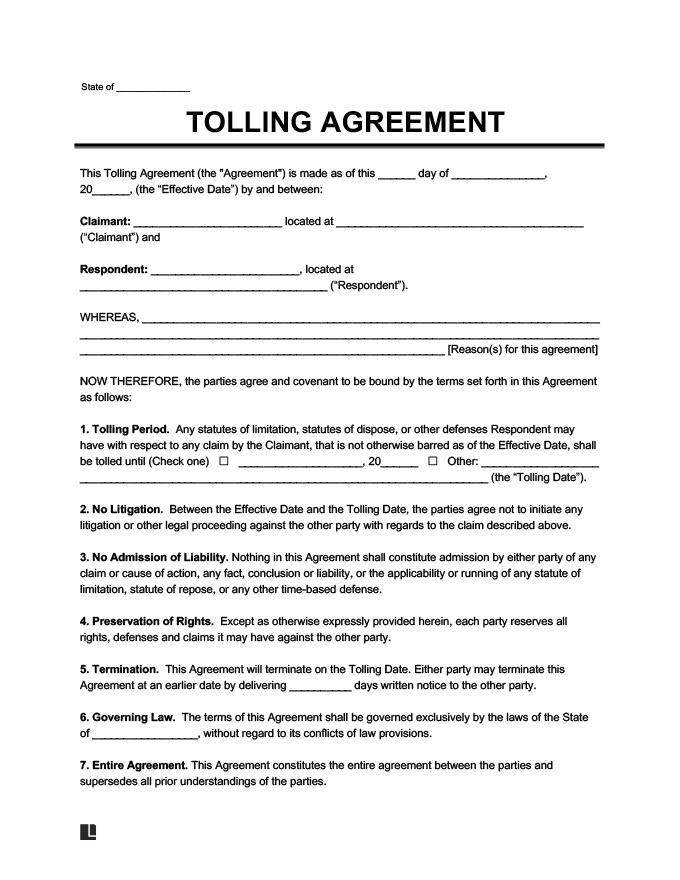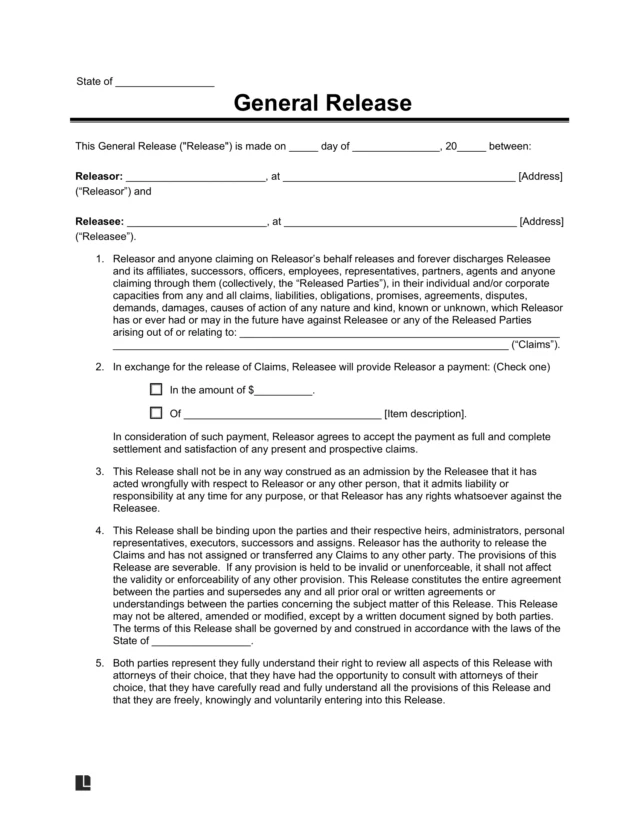A tolling agreement (or a “standstill” agreement) is a legal contract that suspends a time-based statute that may be running on a claim. With this agreement, parties can keep negotiating for a settlement even after a statutory limit expires.
What Is a Tolling Agreement?
A tolling agreement is an agreement between two or more parties who agree to “toll” or “suspend” certain rights, rules, or claims that typically govern legal actions. Some common rights, rules, and claims that both parties may mutually suspend include the statute of limitations and the statute of repose.
The agreement acknowledges the legal time limits that typically govern when lawsuits or crossclaims must be filed. In recognition of a looming time limit, tolling agreements provide a mutual agreement between parties, agreeing to give up their right to use the statute of limitations or the statute of repose as a defense against a lawsuit or crossclaim, should a suit be filed or pursued later.
A tolling agreement in no way concedes guilt, responsibility, or liability. Nor does it waive a valid claim regarding the statute of limitations or the statute of repose before the agreement is implemented. The only right a tolling agreement impacts is a party’s right to argue too much time has passed during the tolling period for a suit to proceed.
Reasons to Consider Proposing a Tolling Agreement
There are many reasons one might benefit from a tolling agreement. Usually, tolling agreements give parties extra time to assess the validity and legitimacy of claims and damages without filing actions within the requisite timeframes. Other common reasons include the following:
Provide Certainty as to the Statute of Limitations or Statute of Repose
The statute of limitations is a law providing for when one can bring a claim after an alleged offense, such as collecting a debt, suing for medical malpractice, or pursuing a contract dispute. Statute of limitations timeframes vary by state, causing uncertainty for many litigants when the actual statute of limitations begins.
In most circumstances, the statute of limitations begins when someone knows or should have known they had a legal claim.
By entering into a tolling agreement, parties have no dispute about the appropriate “end date” of specific claims and rights. Nor do they risk an unfavorable ruling by the court. Instead, the parties can focus on a potential suit’s merits (or lack thereof) and work towards a possible resolution.
Tolling agreements don’t waive valid arguments for a previously expired statute of limitations or repose, only for those during the tolling period.
Offer Certainty as to the Final Date a Suit May be Filed
A tolling agreement details several facts surrounding the date the suit may be filed. In addition to establishing an agreement to suspend the statute of limitations and the statute of repose, a tolling agreement includes an “end date.” The parties agree to waive the statute of limitations and the statute of repose in agreement and that no suit will be filed after a specific date or condition is met.
This waiver allows the parties to investigate and evaluate the strengths and weaknesses of the opposing party’s case and their own, allowing for more meaningful negotiations.
Give Strategic Benefits For Plaintiffs
Plaintiffs benefit from tolling agreements because they can extend their time to investigate and gather evidence to support their claims. Without a tolling agreement and sufficient facts to support an actionable claim before the statute of limitation expires, a plaintiff may forever lose their chance to file a suit.
Provide Benefits For Defendants
Oftentimes, causes of action are settled between parties without a suit ever being filed in court. Court filings are public, and the contents of certain lawsuits can be incredibly damaging to a defendant’s reputation or business. A defendant can pursue a settlement off the record by signing a tolling agreement. A plaintiff may have to file a suit to preserve their claim without one.
Co-defendants may also use tolling agreements when dealing with counterclaims. Counterclaims can include crossclaims and third-party claims. Sometimes, before pursuing a counterclaim against a co-defendant, defendants want to determine the strength of a plaintiff’s case to see if the plaintiff can establish any liability.
Encourage Both Parties to Settle the Dispute
A tolling agreement gives the parties a deadline to negotiate out of court before the plaintiff can follow the legal process. It helps avoid spending money and time in court, allowing both parties to consider out-of-court settlements.
Avoid Litigation Costs
From hiring litigation lawyers to filing counterclaims, litigation costs can add up. A tolling agreement can help prevent these expenses from building up as it pushes both parties toward formally settling the matter. Both parties can receive the benefits of litigation without incurring the costs of initiating litigation.
Alternatively, if negotiations fail, the dispute could be handled through arbitration (an arbitration agreement could avoid litigation in future disputes). With arbitration, a neutral third party will rule after seeing both parties’ cases. Arbitration incurs some costs, but significantly less than going to court.
What to Include in a Tolling Agreement
A typical tolling agreement will identify the following elements:
- Party Information: the identity of the parties to the agreement;
- Start Date: the date the agreement is effective;
- End Date: the date the agreement expires or terminates;
- Tolling Period: the period in which any statutes of limitation, statutes of disposal, or other defenses the respondent may have to any claim by the claimant that is not otherwise barred as of the effective date shall be tolled until;
- Intent Not to Sue: an agreement promising not to commence litigation during the pendency of the tolling agreement;
- Declaration of No Liability: a clear statement indicating no admission of liability by any party;
- Neutrality Statement: a statement affirming the agreement is not for or against any party;
- Waiver of Time-Based Defenses: an agreement that no party shall plead, assert, or claim any time-based defenses that may pass during the tolling period;
- Extension Agreement Date: the date by which any agreement for an extension to the agreement must be reached; and
- Party Signatures: the signatures of the relevant parties.
Consequences of Not Having a Tolling Agreement
There are a variety of consequences for not having a tolling agreement. Keep in mind that the consequences for plaintiffs and defendants are different:
Consequences For Plaintiffs
If a suit has not yet been filed, one of two outcomes may occur without a tolling agreement.
A plaintiff may choose to file a lawsuit within the statute of limitations. This preserves the claim.
Once filed, the parties may continue with discovery, gathering more information. They are also free to discuss a possible negotiated settlement. Sometimes, depending on the facts of the case, the mere threat of filing a suit in court motivates a defendant to settle. By filing the claim, this bargaining chip is lost.
Alternatively, without a tolling agreement, it is possible a plaintiff will not have enough factual evidence to proceed, and any legal claim will be lost because the statute of limitations or the statute of repose has passed.
Consequences For Defendants
On one hand, without a tolling agreement, personal, private, and potentially damaging information may be included in a lawsuit filed by the plaintiff to preserve a claim. On the other hand, without a tolling agreement, it is possible no claim will be filed, and the potential defendant will escape any liability.
In cases where co-defendants might use a tolling agreement, failing to have such an agreement may result in filing counterclaims that aren’t very productive. It is essential to remember tolling agreements don’t prohibit filing counterclaims later.
Instead, it just delays the decision to counterclaim while the parties evaluate the situation based on the evidence the plaintiff may have.
When to Consider Using a Tolling Agreement
There are two critical situations where you should consider using a tolling agreement:
When Deadlines are Approaching
A tolling agreement may be used if either side desires more time to gather evidence. Similarly, if the parties believe they are close to an agreement for a negotiated settlement and don’t want to file a suit, a tolling agreement is useful.
Finally, in cases where the parties disagree about the date and time the statute of limitations began, a tolling agreement can effectively protect all parties from an adverse ruling.
When Co-Defendants Are Involved
Tolling agreements among co-defendants are less common but still occur with some regularity. In some states, co-defendants must file counterclaims while the case is pending and before trial. For strategic reasons, co-defendants may opt for a tolling agreement to give them additional time to assess the strength of a plaintiff’s claims.
As a general rule, tolling agreements are not public. They are, however, contracts; therefore, more detail about the agreement, rather than less, is typically considered better.
Less Common Situations for Tolling Agreements
Some less common situations involving tolling agreements include:
- Cases where some or all of the alleged conduct involved a juvenile plaintiff
- Some bankruptcy proceedings
- When natural or other disasters occur
If either the statute of limitations or the statute of repose has any chance of providing a defense to a suit based on any interpretation of the accrual of a claim, a tolling agreement is a good idea for a plaintiff.
Likewise, for a defendant, the possibility of losing a defense argument based on timing may provide a valid reason to enter into a tolling agreement in an attempt to settle a claim.
Tolling Agreement Sample
View our tolling agreement template, which is available to download as a PDF or Word file:

Frequently Asked Questions
What is the “statute of limitations”?
The statute of limitations defines the time to file suit. The time begins when a given cause of action “accrues.” Depending on the type of legal action at issue, a cause of action begins when it occurs or at the time one knew or should have known there was a legal cause of action.
What is the “statute of repose”?
The statute of repose is a “drop dead date,” after which any cause of action is barred. This applies regardless of the discovery, or lack thereof, of the injury or another legal basis for a claim.
Why do statutes of limitations and statutes of repose exist?
Both the statute of limitations and the statute of repose impose limits on the time allowed between an incident and the filing of a lawsuit. Public policy reasons behind the statute of limitations and the statute of repose are the same. By imposing a deadline, they:
- Preclude the pursuit of claims that are stale (and thus, difficult, if not impossible, to defend);
- Discourage delay; and
- Promote the fair administration of justice.
Are tolling agreements public records?
Typically, tolling agreements are contracts and are not subject to public records. However, there are situations where a tolling agreement may become a public record, such as when there is mass tort litigation.
How long can a tolling agreement last?
A tolling agreement can last for a specific period of time, or it can be indefinite. Both parties need to agree on when the agreement will end. Tolling agreements typically stall the litigation by 90 days.



